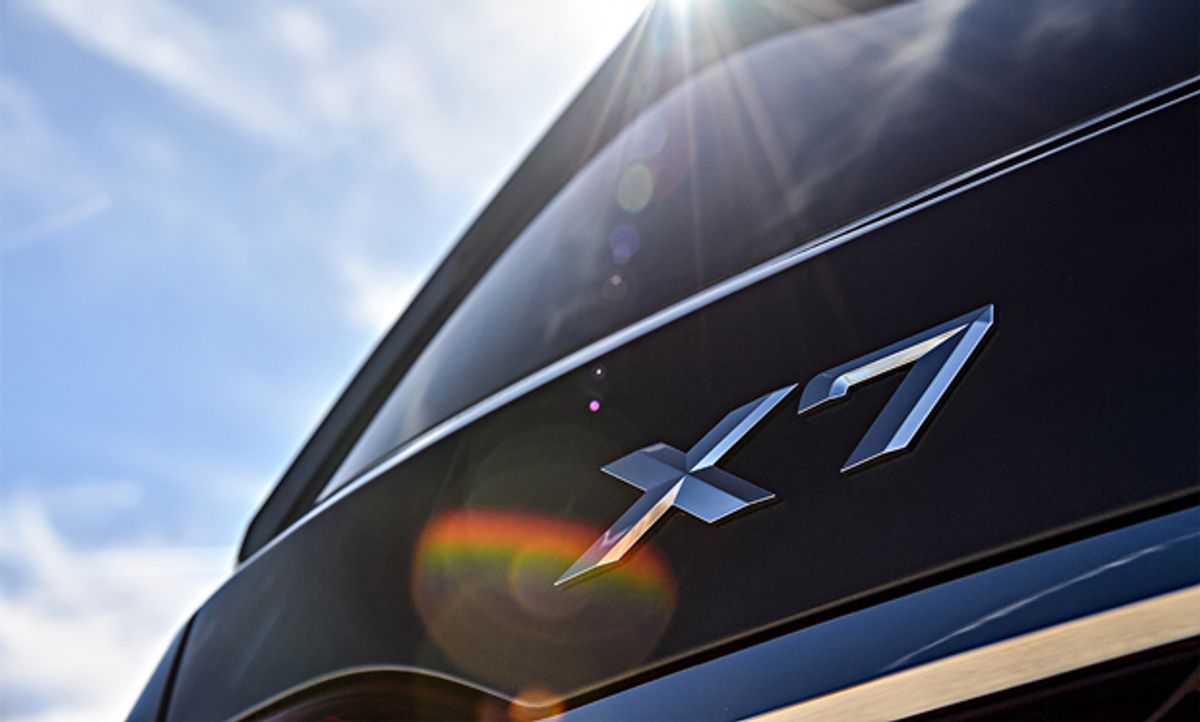If there’s one type of car that could stand to be self-driving, it’s the three-row SUV—America’s de facto family car, the station wagon of our times. Harried moms and dads, with their charges safely belted in back, could use all the robotic help they can get to minimize stress and maximize safety.
As the flagship of the BMW SUV lineup, the new 2020 X7 is not only one of the richest, most-tranquil SUV’s yet created—quieter at 112 kilometers per hour (70 mph) than even a Mercedes S-Class or electric Tesla Model S sedan—it’s also replete with the hardware that has vehicles on the road toward full autonomy. That includes an optical camera (peering from the instrument panel) to ensure that the human pilot is awake and paying attention. Come 2021, the BMW will add a front-mounted, laser-based Lidar sensor to create 3D images of the vehicle’s surrounding. Those two key features are still AWOL on every Tesla model.
Though the X7 presents an example of BMW’s push toward so-called “Level 3” autonomy (it intends to achieve Level 3 by 2021 with a showroom version of its funky Vision i Next electric crossover), the German automaker’s quirky software and control strategies show the brand has work to do to match the best Level 2, no-hands systems such as Cadillac’s SuperCruise and Tesla’s Autopilot. (Level 3, as defined by the Society of Automotive Engineers, remains a somewhat amorphous and even controversial description, but the idea is that drivers will be able to stop paying any attention to the road in certain situations. Vehicles at Level 2 feature advanced driver assistance systems that manage braking and acceleration, as well as lane keeping. But as the name implies, the driver is meant to maintain constant supervision over the vehicle’s operation, with an assist from electronic systems.)
I drove the X7 xDrive 50i version, priced at a cool US $108,000 with options, in an environment that was ideal for testing its new, hands-free “Extended Traffic Jam Assistant”: my Brooklyn neighborhood along New York Harbor, where the crumbling, treacherous freeways often feature, well, extended traffic jams that linger well past midnight. The technology is standard on the V8-powered X7 50i model, and a $1,700 option on the six-cylinder X7. (It’s also available on the one-size-smaller X5).
In addition to the driver-monitoring camera, the system is buttressed by front-racing radar; shorter-range radar sensors at the vehicle’s corners; and a three-camera bundle with microchip controls mounted ahead of the rear-view mirror. The Assistant is designed to operate on limited-access highways, in surrounding traffic, at speeds of 60 km/h or less. BMW, sensitive about its Ultimate Driving Machine reputation, takes pains to note that it’s not ready to cede sporty performance to the machines.

“Our studies show that people get most tired in stop-and-go traffic, where it takes the most brain power,” to stay focused on the driving task, says Oleg Satanovsky, BMW product and technology spokesman. “We’re not taking away the joy of driving, but taking away the burden of driving that people hate the most.”
On both I-278 and the gently curving Prospect Expressway, the system sometimes worked without a hitch. I set my cruising speed and following distance via bright metal controls on the steering wheel. The BMW governed itself accordingly, controlling its own acceleration, braking, and steering during hands-free intervals of roughly 30 to 50 seconds. But my Assistant was also regularly flummoxed by various roadway situations. Those included the dreaded “ping pong” effect, where sensors and controls struggle to keep the car confidently centered in its lane. On dead-straight sections of freeway, the BMW’s steering wheel kept making continuous, intrusive left-right corrections, like a nervous Driver’s Ed student who doesn’t quite get the concept.
The system also regularly shut itself down, even in the stop-and-go conditions for which it’s supposed to be programmed. And those “hand-backs,” where the driver is meant to retake control, were sometimes vague or tardy, with alerts limited to small symbols and green, yellow and red telltales on the instrument panel. One feature I didn’t have the guts to test, at least not in New York: If drivers ignore repeated warnings to get back in the loop, the X7 will brake itself to a safe stop, in case the pilot is incapacitated or asleep.

At one point—and as with “Level 2” units I’ve tested from Volvo, Audi, Acura and others—the X7 missed an upcoming curve entirely (despite being marked by a clearly painted yellow line) and headed straight for the concrete median barrier. Had I not been ready to seize control, the result would most certainly have been a collision. Ultimately, the system just didn’t promote enough confidence for me to fully trust it with hands-off operation. That included situations where I had to squeeze between semi-trucks on the freeway—a literal gauntlet that, say, Cadillac’s SuperCruise system handles with estimable precision and no stress whatsoever.
Now, the X7 is otherwise so sumptuous, powerful, and pleasurable to drive that the Assistant’s foibles are hardly a deal killer. And the SUV’s systems work beautifully when it comes to your basic adaptive-cruise functions, pacing traffic as smoothly as a talented chauffeur. But when it comes to the X7’s Level 2 capabilities, I’ll be keeping my hands on the wheel at all times, thank you very much.
This post was updated on 8 August 2019.
Lawrence Ulrich is an award-winning auto writer and former chief auto critic at The New York Times and The Detroit Free Press.



